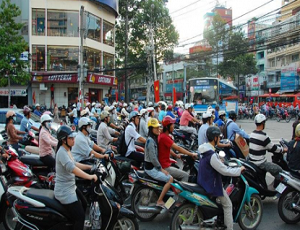Easy Riding – Investment Opportunities in Vietnam’s Motorcycle Industry
By: Erasmo Indolino
 Vietnam is a country where motorcycles are both massively built and sold. Vietnam is not only a huge market where manufacturers can carve out their share – in fact, some recent trends are prompting foreign investors to use Vietnam as an export base throughout the whole Asian region. Knowing the characteristics of the Vietnamese market of motorcycles, on the one hand, and the latest data on the production of motorcycles in Vietnam, on the other hand, it’s crucial for investors seeking success in this dynamic, emerging economic powerhouse.
Vietnam is a country where motorcycles are both massively built and sold. Vietnam is not only a huge market where manufacturers can carve out their share – in fact, some recent trends are prompting foreign investors to use Vietnam as an export base throughout the whole Asian region. Knowing the characteristics of the Vietnamese market of motorcycles, on the one hand, and the latest data on the production of motorcycles in Vietnam, on the other hand, it’s crucial for investors seeking success in this dynamic, emerging economic powerhouse.
Overview of the Motorcycle Market in Vietnam
The two-wheeler industry has long found a fertile market in Asia. Globally, the industry market share allocated to the eastern economies far outweighs that of the West. 79 percent of motorcycles are sold in Asia, while 18 percent in the Americas and 3 percent in Europe. In Asia, China and India are the two main markets. Vietnam carves out a prime spot among the economies of Southeast Asia. In fact, Vietnam is the second largest market in the region, following only Indonesia, making it the fourth largest market for such bikes globally.
 RELATED: International Tax Planning Services from Dezan Shira & Associates
RELATED: International Tax Planning Services from Dezan Shira & Associates
Although in recent years there has been a slowdown in purchases of motorcycles in Vietnam, the two-wheeled vehicles are the most common means of transport and the number of circulating motorcycles is still rising. Each year, about 3 million new motorcycles come on to Vietnamese roads. At the end of 2014, official figures showed that, in a country of nearly 90 million citizens, registered motorcycles amounted to 43 million – basically, almost one in every two Vietnamese owns one. In Ho Chi Minh City alone, the country’s largest, there are over 6.8 million registered motorbikes.
Encouraged by these numbers, many foreign manufacturers continue to invest in the Vietnamese market, introducing new models. Foreign investors account for 90 percent of the domestic market of motorcycles. The five largest brands are Japanese, Italian and Taiwanese: Honda, Yamaha, Piaggio, Suzuki and SYM.
Main Foreign Investors
Honda dominates the market with a share of 60 percent. In 1998, Honda Vietnam has opened its first manufacturing facility in Phuc Thang, in Vinh Phuc province, about 30 kilometers from the capital Hanoi. With a workforce of 3,560 employees, the plant has a production capacity of one million units per year. In 2008, Honda Vietnam has opened a second plant in the same area. With a workforce of 1,375 people, the plant specializes in the production of scooters and engines. At the end of 2014, Honda opened a third plant in the province of Ha Nam, about 60 kilometers from Hanoi, with a production capacity of 500,000 motorcycles a year.
Yamaha Motor Vietnam established its first plant in 1998. With its subsidiary Yamaha Motor Parts Manufacturing, which since 2006 is responsible for the production of components for the engines, its 100,000 square meter plant located in the industrial area of Thang Long Hanoi has more than 6,000 workers.
More recent is the entrance of the Italy’s Piaggio, which opened its first factory in 2009 in Vinh Phuc province. In 2012, Piaggio Vietnam has opened a second plant for the production of engines for scooters, completing the industrial factory that also includes a Center for Research and Development. Piaggio Vietnam has over 800 employees and this makes it the third largest production site of the company, after the Italian and Indian ones. The production capacity is 300,000 vehicles per year. In 2014, Piaggio Vietnam has been awarded as best employer in the Anphabe & Nielsen rank. In the same year, the local government has assigned to the Piaggio Vietnam a “Certificate of Merit awarded to FDI” for its contribution to social and economic development of the Country. In April 2015, Piaggio Vietnam celebrated the production of the 500,000th scooter.
Suzuki first established a presence in Vietnam in 1995 and began producing motorcycles in the following year. The first plant of Vietnam Suzuki was realized in Bien Hoa, in the Long Binh Techno Park, about forty kilometers far from Ho Chi Minh City. Vietnam Suzuki’s plant, which also produces cars, can product almost 100,000 motorcycles a year.
Taiwan’s Sanyang Motor, which produces motorcycles using the SYM brand, has opened its own subsidiary in Vietnam in 1993, called Vietnam Manufacturing & Export Processing (VMEP). As Vietnam Suzuki, also VMEP established its plant in southern Vietnam, in Bien Hoa area. Into the plant are employed a little less than 1,800 workers.
 RELATED: Vietnam Looks to Private Investment to Help its Aviation Industry take Flight
RELATED: Vietnam Looks to Private Investment to Help its Aviation Industry take Flight
Investment Strategies
Despite the large demand within the country, an investment in Vietnam’s motorcycle industry is not without its challenges. On the one hand, the fact that almost half of the Vietnamese people already has a two wheels vehicle causes a risks of market saturation. In fact, it doesn’t seem a coincidence that, although the market continues to grow, sales of motorcycles are slowing. In addition to the saturation of the market, investors should also consider that the progressive increase of the income of a growing middle class is pushing many Vietnamese to invest their earnings in the purchase of cars. While absolute numbers of car sales are much lower compared to motorcycles, Vietnam has become the fastest growing market in South-East Asia. Car sales, in fact, in 2015 increased by nearly 60 percent over their 2014 levels.
On the other hand, there is also a clear intention by the government to reduce the number of motorcycles and discourage purchases. In March 2013, the Prime Minister presented an amendment to the plan of development of road transportation, which states as its objective the reduction of scooters to a total number of about 36 million by 2020. This is due to the chronic lack of transport infrastructure of Vietnam, especially in large cities, resulting in a large traffic congestion with important consequences also for peoples’ health. To this end, Hanoi’s local government has ordered an increase on the cost of registration of motorcycles.
As mentioned above, one of the strategies adopted by motorcycles’ manufacturers in order to keep shares of the Vietnamese domestic market (as well as obtain new ones) is represented by continuous product innovation. In 2014, the five largest foreign producers of motorbikes in Vietnam have presented at least twenty new versions of their models to stimulate a replacement demand.
The second strategy is to use Vietnam as a base to produce motorcycles for export and sell in other Asian economies. Indeed, this is not really a new strategy. For example, opening factories in Vietnam, the Italian Piaggio has enabled has entered into new markets such as Taiwan and, in the case of ASEAN, in countries like Indonesia, Thailand, Malaysia, the Philippines and Cambodia. This new situation is forcing manufacturers to take the opportunity to sell their “made in Vietnam” motorcycles into other economies. For example, Honda is turning its production in Vietnam as a base for exporting to Thailand, Laos, Cambodia, Malaysia, Philippines and Pakistan – but also in Italy and Japan. The inauguration of the third plant in the province of Ha Nam taking place in 2013 (when the slowdown in growth of the Vietnamese motorcycle market had already appeared) confirms Honda’s intentions to focus on exports.
According to some surveys, in 2014 Vietnam’s motorcycle exports reached a value of US $342.4 million. Globally, in the ranking of the largest exporter countries of motorcycles, Vietnam stands in the thirteenth position. At the regional level, Vietnam is sixth, preceded by China, Japan, India, Thailand and Taiwan. In addition, Vietnam is the first country in the world in terms of faster growth of exports of motorcycles: compared to 2010, exports from Vietnam to foreign markets increased by 471.4 percent.
Foreign producers therefore continue to increase their investments in Vietnam. Vietnam, in fact, is very attractive for foreign investment in the field of motorcycles. To produce motorcycles in Vietnam is not only beneficial in terms of low labor costs thanks to low workers’ wages. Investing in Vietnam, in fact, foreign investors can take advantage of the presence of a network of local suppliers strong and well-established. Favorable exchange rates and a favorable tax legislation (compared to other Asian economies) paint a positive picture for investment prospects in Vietnam’s motorcycle industry.
New Frontiers: the Advent of the Electric Two-Wheeled Vehicle
Since the mid-2000s, electric two-wheeled vehicles have entered the Vietnamese market. Despite initial misgivings, also due to the fact that the first products were mainly made in China and with poor quality, in the past few years there has been a huge increase in sales domestically. From 2011 to 2013, Vietnam imported over 1.5 million two-wheeled electric vehicles. Among these, 70 percent constituted electric motorbikes and the remaining 30 percent electric bikes.
According to Vietnamese laws (particularly, according to the Circular No. 39/2013/TT-BGTVT entered into force in 2014), electric motorbikes are those that have an engine with a power lower than four kilowatts, a maximum weight of 118 kilograms and a maximum speed of 50 kilometers per hour. Electric bikes, however, have a weight lower than 40 kilograms, an engine with a power not exceeding 0.025 kW and a maximum speed not exceeding 25 km/h.
Globally, the market for electric bikes is dominated by China: more than 95 percent of electric bikes produced in the world are sold in the People’s Republic of China. Despite the currently small size of the Vietnamese electric two-wheeler market, the wide margins of growth have meant that many foreign manufacturers have entered this market, followed by some local entrepreneurs who have started to compete with foreign investors. For the time being however, 95 percent of the Vietnamese market for electric bikes is dominated by foreign manufacturers (80 percent made by Chinese and Taiwanese enterprises and the remaining 15 percent of the market share held by Japanese and European producers).
Electrics bikes motorbikes are particularly attractive to the young Vietnamese consumer. In addition, according to Vietnamese laws electric bikes don’t require registration or driver’s license, so they are particularly suitable for students. For a population as young as the Vietnamese one, the prospects of a growing market are obvious for investors.
Further Support from Dezan Shira & Associates
With over eight years of experience in the Vietnamese marketplace, the specialists at Dezan Shira & Associates are well placed to assist foreign investors take advantage of opportunities in Vietnam’s motorcycle market. For more information, please get in touch as vietnam@dezshira.com.
|
Asia Briefing Ltd. is a subsidiary of Dezan Shira & Associates. Dezan Shira is a specialist foreign direct investment practice, providing corporate establishment, business advisory, tax advisory and compliance, accounting, payroll, due diligence and financial review services to multinationals investing in China, Hong Kong, India, Vietnam, Singapore and the rest of ASEAN. For further information, please email vietnam@dezshira.com or visit www.dezshira.com. Stay up to date with the latest business and investment trends in Asia by subscribing to our complimentary update service featuring news, commentary and regulatory insight. |
Import and Export: A Guide to Trade in Vietnam
In this issue of Vietnam Briefing Magazine, we provide you with a clear understanding of the current business trends related to trade in Vietnam, as well as explaining how to set up your trading business in the country. We also attempt to give perspective on what will be Vietnam’s place in the Association of Southeast Asian Nations (ASEAN) in 2015, and look at some of the country’s key import and export regulations.
 Navigating the Vietnam Supply Chain
Navigating the Vietnam Supply Chain
In this edition of Vietnam Briefing, we discuss the advantages of the Vietnamese market over its regional competition and highlight where and how to implement successful investment projects. We examine tariff reduction schedules within the ACFTA and TPP, highlight considerations with regard to rules of origin, and outline the benefits of investing in Vietnam’s growing economic zones. Finally, we provide expert insight into the issues surrounding the creation of 100 percent Foreign Owned Enterprise in Vietnam.
 Tax, Accounting, and Audit in Vietnam 2014-2015
Tax, Accounting, and Audit in Vietnam 2014-2015
The first edition of Tax, Accounting, and Audit in Vietnam, published in 2014, offers a comprehensive overview of the major taxes foreign investors are likely to encounter when establishing or operating a business in Vietnam, as well as other tax-relevant obligations. This concise, detailed, yet pragmatic guide is ideal for CFOs, compliance officers and heads of accounting who need to be able to navigate the complex tax and accounting landscape in Vietnam.
- Previous Article Vietnam – Latin America Trade: Complementary Economies under the TPP
- Next Article Decree 118/2015: A Guide to Vietnam’s Evolving BIT Policy


































